The presentation, dated March 11, 2019, includes slides used to present the information necessary to understand the rationale for zoning changes, the location of the zoning areas under consideration and the charts, tables and maps that help describe the situation. The proposed zoning changes, especially articles 6, 7, 8, 11 and 16, only cover changes affecting about 7% of the Town, those parts of the Town that are currently zoned R4-R7 and the B zoning districts.
Related articles
You may not know who your Town Meeting Members are. You may not even know what precinct you live in. We’re here to help!
What’s My Precinct?
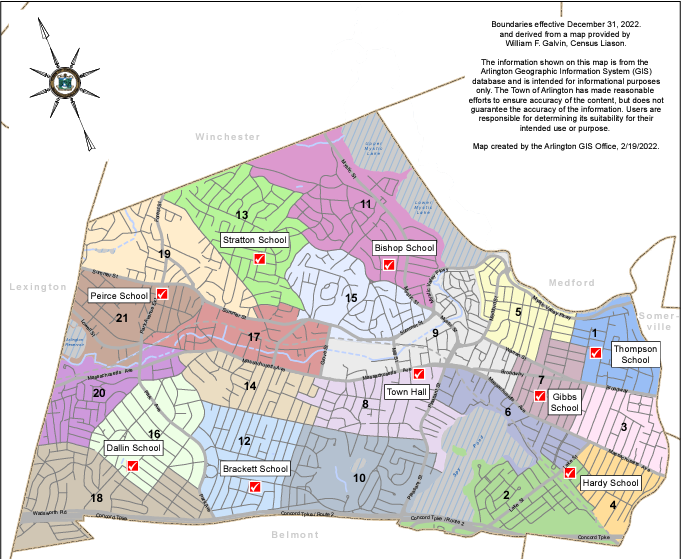
This PDF map of Arlington is divided by precinct. You may need to zoom in to see your precinct.
Who Are My Town Meeting Members?
The town of Arlington has a public list of town meeting members and their contact information. Send them an email telling them how you feel, or ask them if you can take a walk and discuss the MBTA Communities Plan.
by Beth Elliott
I’m a member of the Affordable Housing Trust Fund Board and an attorney with over 15 years of practice in affordable housing law. Views expressed are my own, not those of the Trust.
The Town of Arlington and the Arlington Affordable Housing Trust Fund have created the Acquisition, Creation and Conversion (ACC) Program to provide a flexible source of funding for creating deed-restricted affordable housing in Arlington. Up to $250,000 is available per restricted unit, and the Town has dedicated federal ARPA funds to support the ACC Program.
ACC Program funds can be used to build new deed-restricted affordable units, whether rented or owned. ACC funds can only be used for existing units if the current tenants will not be displaced.
“Deed-Restricted” Is Important
“Deed-restricted” is the key component here. Housing that is “deed-restricted” as affordable housing is protected by a legally binding agreement that is recorded against the property in the registry of deeds. This agreement specifies the levels of affordability that must be maintained and for how long. It’s a public commitment to provide affordable housing that binds the current owner of the property as well as anyone else who buys the property while the restriction is in place. The ACC Program requires affordability for at least 20 years for rental units and in perpetuity for homeownership units. For rental properties, this means that tenants know that their units will remain affordable for the long term, even if their landlord changes.
Personally, I’m most excited about the potential to use the ACC Program to apply these protections to existing naturally occurring affordable housing in Arlington. For example, if an owner of an existing apartment building participates in the ACC Program, some or all of the apartment units will become deed-restricted affordable housing. Because ACC Program funds can only be used if the existing tenants aren’t displaced, this locks in deed-restricted affordability for the existing tenants. This innovative feature of the program is rare in my experience of affordable housing programs, and it has RFP potential to make meaningful change for existing tenants of naturally occurring affordable housing.
Get the Full Rules
In addition, the ACC Program can be combined with other funding sources, so there is great opportunity for owners to propose their own solutions. The Request for Proposals (RFP) issued for the ACC Program, available here, provides the full rules for participating in the program.
In the past few weeks, a number of highly respected Arlington organizations have come out in support of the MBTA Communities Plan. Here are a few. We will continue to update this list as it grows.
Greater Boston Interfaith Organization
This week the Greater Boston Interfaith Organization’s Arlington members released a letter of support, stating:
Arlington GBIO members support the Arlington Redevelopment Board’s proposal for the Article 12 of the Fall 2023 Special Town Meeting (MBTA Communities Overlay District) to enact changes in Arlington’s zoning by-laws that will allow for more multi-family housing to be built by right. We support an article that goes beyond the minimum capacity required by law in order to encourage the construction of a meaningful number of additional homes of various sizes beyond the number already present in Arlington.
Arlington Chamber of Commerce
The Arlington Chamber of Commerce sent a letter supporting the MBTA Communities Plan on October 2, saying:
The Arlington Chamber of Commerce believes that the MBTA Working Group’s proposal presents a strong plan for both housing and commercial growth. Arlington’s existing and future small businesses will benefit from an increased customer base and foot traffic resulting from additional housing units.
Division of Diversity, Equity and Inclusion
Arlington’s Division of Diversity, Equity and Inclusion wrote to the Arlington Redevelopment Board in support of the MBTA Communities Plan:
The DEI Division would like to formally voice our support for the Working Group’s effort to create a zoning plan that would allow for more multi-housing opportunities at varied price points across Arlington. Only 9% of Arlington’s land is devoted to multifamily housing, and even where building multi-family housing is allowable, it is not permitted by right. This does not provide suitable conditions for a range of housing types to exist. The current price point of homes in Arlington are far beyond the reach of most residents, regardless of their status as a member of a protected class. stating:
Read the full letter. [PDF]
Clean Energy Future Committee
The Clean Energy Future Committee said passage of the MBTA Communities Zoning was crucial because:
Passage of the MBTA Communities zoning amendment at this fall’s Special Town Meeting is the only viable pathway for Arlington to participate in the State’s Fossil Fuel Free Demonstration Program (Demonstration Program), which would allow implementation of the Clean Heat bylaw and home rule petition passed overwhelmingly by Arlington Town Meeting in 2020. Participation in the Demonstration Program will allow the Town to prohibit the installation of natural gas, oil, propane, and other fossil fuel infrastructure in new buildings and major renovations. Town Meeting sent a clear message in 2020 that enacting the Fossil Fuel Bylaw was a priority, and we–the CEFC, Town administrators, and elected and appointed bodies–have an obligation to act upon that priority; passage of the MBTA Communities zoning amendment is an essential step to carrying out the will of Town Meeting.
Mothers Out Front
As we previously reported, the Arlington chapter of Mothers Out Front supports the MBTA Communities Plan, writing:
A revised zoning by-law to allow for more multi-family housing will reduce pressure to build single family homes on undeveloped land elsewhere in Massachusetts. This safeguards undisturbed ecosystems and provides real alternatives to automotive commutes in the region, reducing both congestion and fossil fuel emissions.
WE HAVE WINNERS!
MIT Dept. of Urban Studies and Planning
Jay Maddox maddoxja@mit.edu; Shannon Hasenfratz shasenfr@mit.edu; Daniel Pratama danielcp@mit.edu
Title: EAST ARLINGTON COMPLETE NEIGHBORHOOD
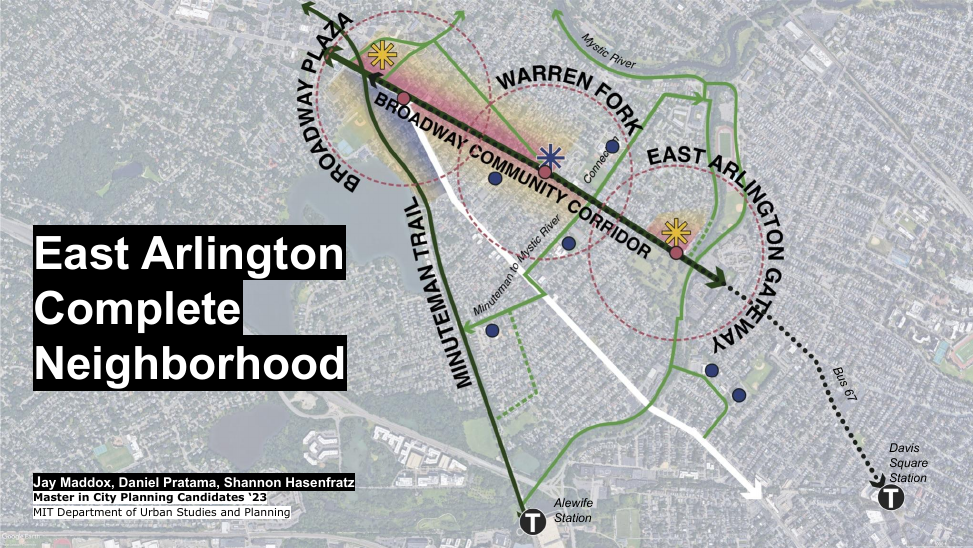
Arlington High School CADD Program
Petru Sofio psofio2024@spyponders.com; Talia Askenazi taskenazi2025@spyponders.com
Title: ENVISION BROADWAY
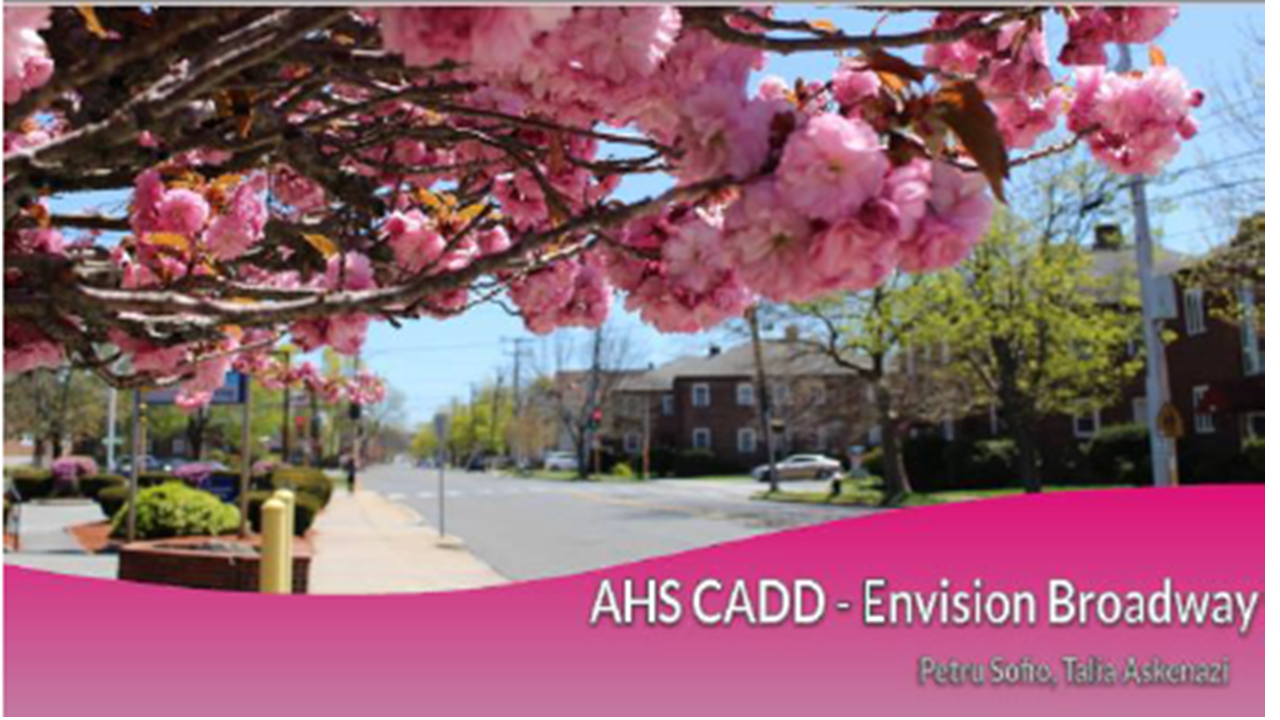
Winslow Architects
John Winslow john@winslowarchitects.com; Phil Reville philip@winslowarchitects.com; Dolapo Beckley dolapo@winslowarchitects.com
Title: REDEFINING THE BROADWAY CORRIDOR: A 2040+ VISION
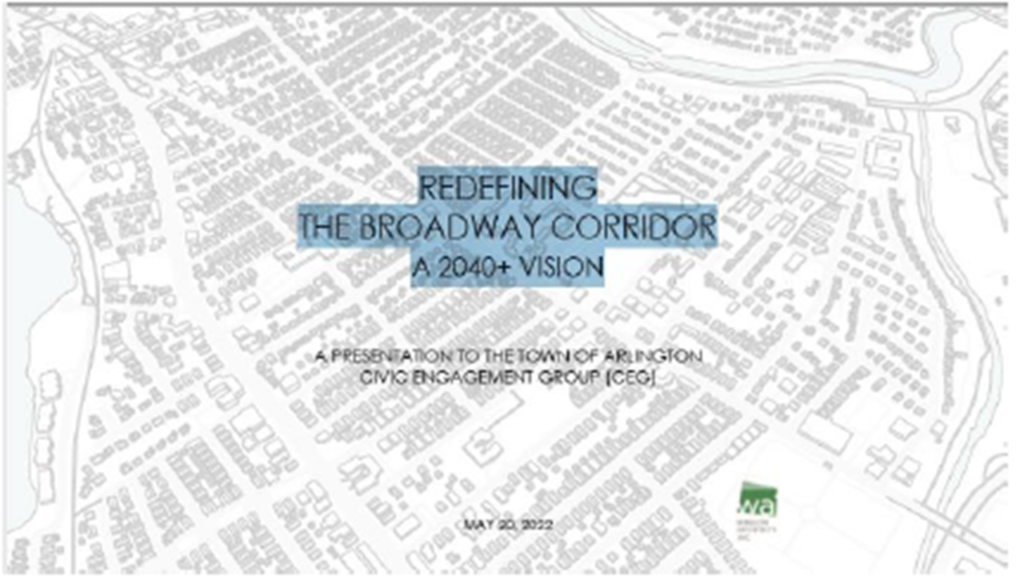
Contest Personnel
- Judges: Adria Arch, artist; Caroline Murray, construction project manager; Rachel Zsembery, architect
- Organizer: Barbara Thornton
- Host: Lenard Diggins, Chair, Arlington Select Board
- Sponsor: Civic Engagement Group, Envision Arlington, Town of Arlington MA
- Producer: ACMI
Special thanks
- ACMI production team: Katie Chang, James Milan, Jeff Munro, Jason Audette, Anim Osmani, Jared Sweet, Michael Armanious
- Civic Engagement Group (CEG): Greg Christiana, Len Diggins
- Jenny Raitt- Arlington DHCD Director, for laying the groundwork with the 2019 Broadway Corridor Study
- Jeffrey Levine, MIT DUSP faculty, led the original 2019 Broadway Corridor study team
- Kambiz Vatan & Cinzia Mangano, AHS CADD faculty and community volunteer
- Jane Howard, whose volunteer efforts over many years made possible Vision 2020 and Envision Arlington, leading to CEG and thus making this project possible by giving our town of Arlington the infrastructure, the “DNA”, to make this kind of civic engagement happen.
Background
The Civic Engagement Group (CEG), part of the Town of Arlington’s Envision Arlington network of organizations, is sponsoring the Broadway Corridor Design Competition. Architects, planners, designers and artists from around the region are encouraged to register by April 8, 2022.
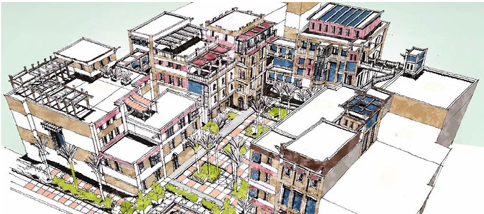
This as an opportunity for designers and architects in the region to have some fun exercising real creativity to leapfrog into the post pandemic future and create a 2040+ VISION of what the built environment of a specific neighborhood (our Broadway Corridor area) might look like.
Although the cash prize is small, the pay off will be bragging rights, recognition and a possible opportunity to help shape the upcoming Arlington master plan revision process.
The information: flyer
The plan: Design Competition launch plan
The background data: 2019 Broadway Corridor Study
Register to enter: Sign up information
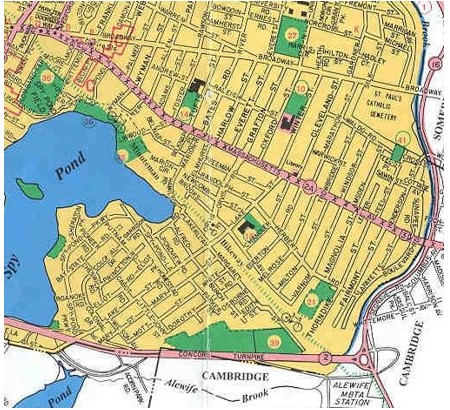
Broadway St. is a major bus route and transit corridor through Arlington to Cambridge. It is close enough to the Alewife MBTA Station to possibly be, at least partially, included in the planning for Arlington’s “transit area” status under the state Dept. of Housing and Community Development’s new guidelines.
The discussions on zoning have been confusing because while zoning covers ALL of Arlington’s land and the zoning bylaws for all Arlington’s zones are referenced, the key issues of greatest interest to Town Meeting are the discussions about increasing density. These discussions pertain ONLY to those properties currently zoned as R4-R7 and the B (Business) districts. These density related changes would affect only about 7% of Arlington’s land area. The map shows the specific zones that would potentially be affected. They lay along major transportation corridors.

Article 16 is a proposal to encourage the production of affordable housing in the town of Arlington. I brought this article to town meeting for several reasons, namely, our increasing cost of housing and our increasing cost of land. Arlington is part of the Metropolitan Boston area; we share borders with Cambridge, Somerville, and Medford, and are a mere 5.5 miles from Boston itself. Years ago, people moved out of cities and into the suburbs. That trend has reversed during the last decade, and people are moving back to urban areas, including Metro-Boston. Metro-Boston is a good source of jobs; people come here to work and want to live nearby. That obviously puts pressure on housing prices, and Arlington is not immune from that pressure.
Another reason for proposing Article 16 was my desire to start a conversation about the role our zoning laws play in the cost of housing, and how they might be used to relieve some of that burden. During the 20th century people discovered that one cannot draw a line on a map and say “upper-class households on this side, lower-class households on that side”, but one can draw a line on a map and say “single-family homes on this side, and apartments on that side”. For all practical purposes, the latter achieves the same result as the former. When zoning places a threshold on the cost of housing, it determines who can and cannot afford to live in a given area.
Today 70% of Arlington’s land is exclusively zoned for single family homes, the predominant form of housing in town. In 2013, the median cost of a single-family home was $472,850; this rose to $618,800 in 2018 — an increase of 31%. We can break this down further. The median building cost for a single-family building rose from $226,300 in 2013 to $248,100 in 2018 (an increase of 9.6%), and the median cost for a single-family lot rose from $243,700 to $360,900 (an increase of 48%). Land is a large component of our housing costs, and it continues to rise. Certain neighborhoods (e.g., Kelwyn Manor) saw substantial increases in land assessments in 2019, enough that the Assessor’s office issued a statement to explain the property tax increases. To that end, multifamily housing is a straightforward way to reduce the land costs associated with housing. Putting two units on a lot instead of one decreases the land cost by 50% for each unit.
Article 16 tries to encourage the production of affordable housing (restricted to 60% of the area median income for rentable units and 70% for owner-occupied units). It works as follows:
- Projects of six or more units must make 15% of those units affordable. This is part of our existing bylaws.
- Projects of twenty or more units must make 20% of those units affordable. This is a new provision in Article 16.
- Projects of six or more units that produce more than the required number of affordable units will be eligible for density bonuses, according to the proposed section 8.2.4(C). Essentially, this allows a developer to build a larger building, in exchange for creating more affordable housing.
- Projects of six or more units that produce only the required number of affordable units are not eligible for the density bonuses contained in 8.2.4(C).
- Projects of 4-5 units will be eligible for the density bonuses in section 8.2.4(C), as long as they are of a use, and in a zone contained in those tables. This provision is intended to permit smaller apartments and townhouses, filling a need for residents who don’t necessarily want (or may not be able to afford) a single-family home. This provision can help reduce land costs by allowing a four-unit townhouse in place of a duplex, for example.
Historically, Arlington has had mixed results with affordable housing production, mainly due to the limited opportunity to build projects of six units or more. It is my hope that the density bonuses allow more of these projects to be built.
In conclusion, the problem of housing affordability in Arlington comes from a variety of pressures, is several years in the making, and will likely take years to address. I see Article 16 as the first step down a long road, and I ask for your support during the 2019 Town Meeting. I’d also ask for your support on articles 6, 7, and 8 which contain minor changes to make Article 16 work properly.
In 2015 Town Meeting approved the Master Plan. Following is the Housing chapter of that plan. It contains a great deal of information about details of the housing situation in Arlington, challenges of housing price increases, needs for specialty housing, opportunities for meeting these needs, etc. The authors found that “most cities and towns around Arlington experienced a significant rise in housing values from 2000 to 2010. A 40 percent increase in the median value was fairly common. However, Arlington experienced more dramatic growth in housing values than any community in the immediate area, except Somerville. In fact, Arlington’s home values almost doubled.” This and related data helps explain why the need for affordable housing is now so acute.
(Contributed by HCA Board Member Laura Wiener, and Executive Director Erica Schwarz)
The Housing Corporation of Arlington (HCA), the Town’s non-profit housing developer, is excited to create a new development on Sunnyside Ave with 43 new affordable homes. The homes will be a diverse mix of sizes and serve people of different incomes, all under 60% of the area median income. Arlington and the entire Greater Boston region have a severe shortage of affordable housing, which this project will help to address. Arlington’s Master Plan, Housing Plan, and Housing Trust Action Plan all acknowledge the need to create significantly more affordable housing.
The HCA’s new Sunnyside Ave proposal is located just off Broadway, near the Alewife Brook DCR Greenway and the Somerville line; it’s a great location near a supermarket, bus lines, and a modest walk to Davis Square. Currently, the site is a dilapidated former auto body shop. The proposal is designed to meet the specific needs of HCA’s residents and the Arlington community. The development will be Passive House certified. It includes 21 vehicle parking spaces, approximately 70 bike parking spaces, and a 2nd floor roof garden for tenants to enjoy. The development also includes a community room that the HCA will share with other local groups. The project will also add a sidewalk on Sunnyside Ave where there currently isn’t one. HCA owns the site and expects to start seeking zoning approval in the spring.
Building affordable housing is a long and complicated process, due to the permitting process plus the number and complexity of funding sources needed. The state’s Department of Housing and Community Development receives many more requests than they can fund in every funding round. We expect to complete the permitting process in 2023, secure our financing by the end of 2024, and start construction in early 2025. With an expected construction timeline of around one year, HCA expects to see tenants moving into the building in spring, 2026. A public forum on the project is anticipated in the coming months. Given the complicated funding and permitting challenges, your monetary and public support of our new development on Sunnyside Ave would be appreciated.
The Housing Corporation of Arlington is a non-profit, community-based developer and owner of affordable housing in Arlington. It owns 150 units of affordable rental housing in all parts of town. The units are occupied by a diverse mix of families and individuals. HCA has been purchasing, rehabilitating, and building new housing since 2000, and also provides social service programs to support family stability and build community connection and engagement. Every week, HCA staff help local families who are struggling with the extreme cost of housing, making the creation of more affordable homes both urgent and important.
The staff, board of directors, and the more than 1,000 tenants, donors, and members who make up the HCA organization are very excited about this opportunity to expand Arlington’s portfolio of affordable housing. Our most recent projects included three newly constructed buildings—two in Downing Square (Lowell Street) and a mixed-use property shared with “Arlington Eats” on Broadway. To learn more about HCA or apply for housing, go to: https://www.housingcorparlington.org.
